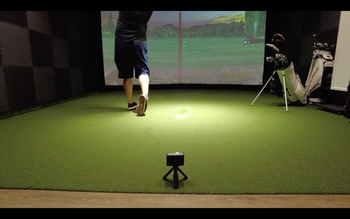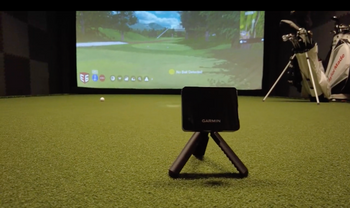Let's be honest - nothing kills the excitement of new golf tech faster than bad data. You finally pulled the trigger on that launch monitor you've been eyeing for months. The delivery truck shows up, you tear open that box like it's Christmas morning, and you're ready to transform your game with instant feedback on every swing.
Then reality hits harder than a hosel rocket.
Your 7-iron that usually flies 150 yards? The monitor says 95. That buttery drawer you've been working on? According to this thing, you're slicing it 40 yards right. Something's clearly wrong here, and suddenly that excitement turns into buyer's remorse.
Trust me, you're not the only one who's wanted to launch their launch monitor into the nearest water hazard. Plenty of golfers have gone through this exact same roller coaster of emotions.
Here's the thing, though - before you box it up and ship it back, pump the brakes. Your new tech toy probably works just fine. The real issue? Most golfers set these things up wrong and then blame the equipment.
Sure, sometimes you'll get a lemon straight from the factory. It's rare, but it happens. And yeah, if you went bargain hunting and grabbed the cheapest option on Amazon, you probably got what you paid for. Those $200 "launch monitors" are basically expensive paperweights.
But assuming you invested in quality gear from a reputable brand, the accuracy should be solid. Modern launch monitors use the same radar and camera tech that tour pros rely on - they don't just make up numbers.
The setup process trips up more golfers than a downhill putt at Augusta. Each monitor has its own quirks and requirements that you must meet if you want reliable data.
Unfortunately, we can't walk through every possible glitch with every device out there. New models drop faster than weekend hackers lose Pro V1s, and each one has its own personality.
What we can do is hit the most common mistakes that send golfers into a tailspin. Plus, we'll dig into the typical gotchas with today's popular models that actually deliver when you use them right.
Bottom line - don't give up on your investment yet. With a few tweaks to your setup, you'll likely start seeing numbers that actually make sense and help you improve. Your golf tech dreams are still alive, trust me.
Table of Contents
Master the Manual - Essential Reading Before You Start
Look, you just dropped serious cash on a launch monitor and you're dying to start bombing drives, right? Trust me, though, those boring setup guides are actually your secret weapon.
Here's the thing - every frustrated golfer who's called their launch monitor "garbage" usually missed something ridiculously simple in the manual. You know what's wild? Half the time, it's just about where you're placing the thing.
Those instruction booklets are tiny these days - we're talking maybe 10 pages max. That's like a bathroom break's worth of reading, and it'll save you from wanting to chuck your new tech into the water hazard.
You'll discover the exact sweet spot for positioning your unit. Maybe it needs to sit 8 feet behind your ball, not 6. Perhaps there's a minimum distance requirement for ball flight that you're cramming into too small a space. Sometimes your buddy's cart or that metal fence is screwing with the radar signals.
The manufacturers spell out every little quirk that could mess with your numbers. They'll tell you about interference from overhead nets, how humidity affects readings, and why your garage ceiling might be too low for accurate spin rates.
Sure, these gadgets are pretty user-friendly right out of the box. You can probably get decent readings just winging it. But when you're trying to dial in your 7-iron distance or figure out why your driver spin is through the roof, those setup details matter big time.
Take 15 minutes with that manual while you're having your pre-round coffee. Your scorecard will thank you when you're suddenly hitting your targets because you actually know what those numbers mean.

Keep Your Device Smart - Updating Software and Firmware for Peak Performance
You know that frustrating tech issue that's been driving you crazy on the course? The fix might be simpler than you think.
Software updates are like getting your clubs regripped - everyone knows they should do it, but most of us put it off way too long. Your device manufacturer is constantly tweaking their code to squash bugs and improve performance. These updates roll out specifically to address the exact headaches you're probably dealing with right now.
Here's the thing, though - tons of golfers either never check if updates exist, or they see that little notification and swipe it away faster than a topped drive heading for the water. Sound familiar?
Think of updating your gear's software like cleaning your grooves after a muddy round. It's basic maintenance that takes five minutes but makes everything work better. Those updates sitting there waiting? They're not going away, and ignoring them is like playing with dirt-packed wedges when you need that perfect spin.
Make it part of your routine - when you see an update notification, just tap install. Your future self will thank you when everything's running smoothly as a fresh-rolled green instead of glitching out when you need it most.
Perfect Your Setup - Why Precise Alignment Matters Most
You know what drives me crazy? When guys drop serious cash on a launch monitor and then wonder why their numbers look wonky. Nine times out of ten, they've got the thing sitting crooked or pointing the wrong direction.
Getting your launch monitor lined up properly makes the difference between data you can actually use and numbers that'll have you chasing your tail. Doesn't matter if you've got a radar unit or one of those camera-based systems - if the alignment's off, you might as well be guessing your distances.
Think about it - these machines need to see exactly where you're standing and exactly where you're aiming. Plus, the ground beneath them needs to be flat as a pancake. Miss any of those details and your expensive new toy becomes an expensive paperweight.
I've watched buddies set up their FlightScope Mevo+ (which, by the way, is a beast when you nail the setup). The thing can give you tour-level data, but man, you've gotta be patient with the alignment process. It's not rocket science - more like parallel parking. Takes a few extra minutes, but once you get it right, the numbers it spits out are money.
Here's what kills me about radar units - people just plop them down anywhere. Your manual tells you exactly how far to place it behind the ball and how much space you need to your net or screen when you're hitting indoors. Those aren't suggestions, they're requirements. Skip that part and you'll be scratching your head wondering why your 7-iron suddenly shows 200 yards of carry.
Now, if you're the type who wants to just turn it on and go, camera-based launch monitors might be your jam. You still need to position them correctly, but it's way more straightforward, kinda like the difference between assembling IKEA furniture and just moving a couch.
The good news? Every quality launch monitor out there will nail your numbers when you set it up right. The bad news? Even the most expensive unit turns into a fancy guess-o-meter when you rush through setup. Take your time at first - after a few sessions, you'll have the routine down and it'll take you 30 seconds instead of 5 minutes.
Taming Tech Disruptions - How Your Environment Impacts Launch Monitor Accuracy
You know how your Wi-Fi gets wonky when you microwave popcorn? Golf launch monitors face the same headache, especially those radar-based units that everyone's buying because they're cheaper.
Here's the deal - if you're setting up shop in your garage or basement, you've got to think about what's already in there. Your AC unit, that old fridge humming in the corner, even those flickering fluorescent lights, can mess with radar technology big time. It's like trying to hear your buddy's joke at a rock concert - too much noise drowning out the signal.
Camera-based launch monitors dodge this whole mess. They don't care about your ceiling fan or that space heater you're running. They just watch your ball and club do their thing, no interference drama.
Now, radar units need another thing that'll drive you crazy indoors - space. These bad boys want to track your ball way downrange to nail those numbers. Ever tried hitting a driver in a room that's barely longer than your living room? Yeah, not happening. The radar gets confused faster than a tourist at Augusta National.
Camera systems work their magic in tight spots. Set one up, and you're getting solid data whether you've got 10 feet or 50 feet to work with. Perfect for us normal folks who don't have airplane hangars for practice facilities.
Sure, you'll shell out more cash upfront for a camera unit. But think about it - you're already dropping serious coin on a simulator setup. Why cheap out on the most important piece and end up with readings jumpier than your nerves on the first tee?
Bottom line: if you're going the indoor route, especially in spaces packed with electronics and metal stuff, cameras beat radar every time. You'll get consistent numbers, save yourself the headache of troubleshooting interference, and actually improve your game instead of fighting with your equipment.

Prep Like a Pro - Ensuring Your Ball and Club Are Ready for Reliable Results
You know those stickers and special balls you need for launch monitors? Yeah, they're gonna be part of your life if you want the full data package – spin rates, club path, face angle, the whole nine yards. Well, unless you snag that new Uneekor XR that just dropped at the PGA Show. That bad boy's the first launch monitor that'll track everything without any extras, but it's gonna cost you.
Here's where it gets tricky. You can't just slap any sticker on your driver and call it good. Trust me, I learned this the hard way. Each launch monitor brand needs its own specific type – those little reflective dots they call fiducials. Stick the wrong ones on, and you'll think your launch monitor's broken when really you're just confusing its cameras.
Picture this: You're crushing drives on your sim, but the numbers look wonky. Your buddy's Foresight stickers won't play nice with your Garmin R50 setup. Those Garmin stickers? They're huge compared to others, so you'll need to peel off the old ones and start fresh. Pain in the butt? Sure. But it beats getting garbage data that'll mess with your head.
The golf ball situation's just as picky. Your Garmin R10 needs those RCT balls with the special markings, while the Rapsodo wants RPT balls. Mix 'em up and you'll miss out on spin data – basically throwing away half of what you paid for.
Bottom line: Match your balls and stickers to your specific launch monitor brand. It's like putting regular gas in a diesel truck – seems like it should work, but you're gonna have a bad time. Once you get the right setup, though? You'll see every detail of your swing, from that little out-to-in path you've been fighting to exactly how open your face is at impact. That's the kind of feedback that actually drops your scores.
Understand the Boundaries - What Your Launch Monitor Can and Can’t Do
You might be surprised to learn the SkyTrak+ struggles when you're hitting balls from actual fairway grass instead of a mat. That's just one of those quirky things about launch monitors that catches folks off guard.
Here's another one - if you're thinking about the Square Golf Launch Monitor, keep it inside. The thing just doesn't play nice with outdoor conditions.
Got your eye on a Mevo+? Better check your practice area first. If there's any kind of slope or depression between where you set it up and where you're hitting from, your numbers won't be worth much.
And those camera-based systems? They'll give you some wild readings if the sun's beating down on them. It's like trying to read your phone screen at the beach - the technology just can't handle that bright light.
Bottom line - you've gotta do your homework before dropping serious cash on any launch monitor. Check out what the experts at Golfers Authority are saying in their reviews. Every unit has its quirks and limitations that might mess with how you want to use it.
The perfect launch monitor for your buddy might be totally wrong for your setup. Think about where you'll use it, what conditions you'll face, and what specific data you need for your game. There's no one-size-fits-all answer here, and knowing these little gotchas upfront will save you from buyer's remorse later.
Fast Fixes - Your Go-To Troubleshooting Guide for Launch Monitor Issues
Your launch monitor isn't some genius device that reads your mind - it needs you to set it up right. Think of it like your driver: even the best one won't help if you're teeing up backwards.
Yeah, sometimes you'll get a lemon straight from the factory. Pretty rare, but it happens to the best of us. If you snagged yours from Golfers Authority, they'll sort you out no problem.
Here's the thing, though - nine times out of ten, whatever's driving you nuts with your launch monitor is something you can fix yourself in about five minutes. Usually, it's one of those forehead-slapping mistakes we've all made.
So before you start cursing out your expensive tech, run through this checklist:
First up - alignment. You've got to make sure that bad boy is sitting perfectly level and aimed dead-on at your target. Even a few degrees off can mess with your numbers.
Next, check out where you're hitting. Direct sun will blind these things faster than looking at your scorecard after a triple bogey. Watch out for weird electrical stuff nearby too, and make sure you're on flat ground.
Don't forget to update the thing. These monitors need their software refreshed just like your phone does. Old firmware equals wonky readings.
Here's where people really mess up - the golf balls. Some monitors need special balls with those reflective stickers (called RCT or RPT balls). Others want those little dot stickers on your clubs (tech folks call them fiducials). Use the wrong setup and you might as well be guessing your distances.
Last but not least, spacing matters big time. Each monitor has its sweet spot for how far it should sit from your ball and your hitting screen or net. Too close or too far, and your data goes haywire.
Look, I get it - you dropped serious cash on this thing and you want it working perfectly. Just run through these basics before you lose your mind. Treat your launch monitor right, and it'll give you the data you need to finally break 80 (or 90, no judgment here).





